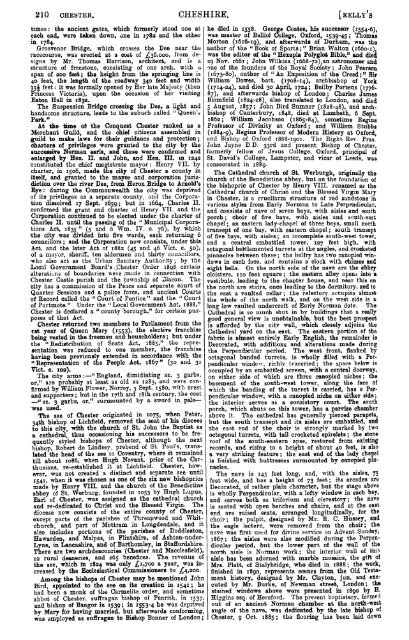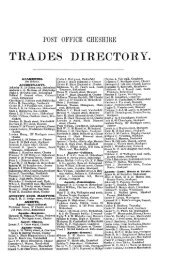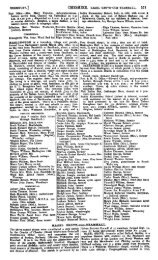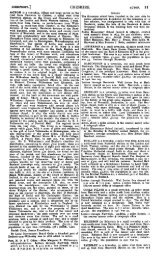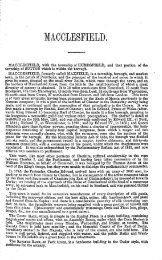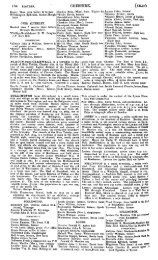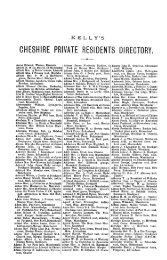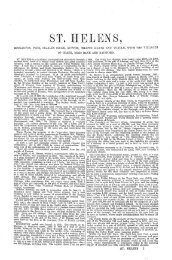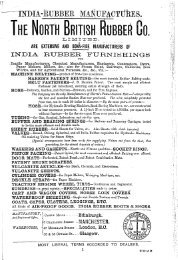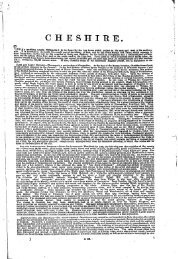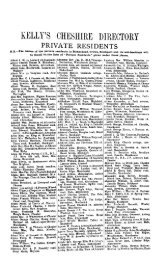bowdon. - Cheshire County Council - Cheshire County Council ...
bowdon. - Cheshire County Council - Cheshire County Council ...
bowdon. - Cheshire County Council - Cheshire County Council ...
- No tags were found...
Create successful ePaper yourself
Turn your PDF publications into a flip-book with our unique Google optimized e-Paper software.
210 CHESTER. CHESHIRE. [KELLY'Stimes: the ancient gates, which formerly stood one ateach end, were taken dovra, one in 1782 and the otherin 1784.Grosvenor Bridge, which crosses the Dee near theracecourse, was erected at a cost of ^^36,000, from designsby Mr. Thomas Harrison, architect, and is astructure of freestone, consisting of one arch, with aspan of 200 feet; th» height from the springing Une is40 feet, the length of the roadway 340 feet and 'width35^ feet: it was formaUy opened by Her late Majesty (thenPrincess Victoria), upon the occasion of her visitingEaton HaU in 1832.The Suspension Bridge crossing the Dee, a Hght andhandsome structure, leads to the suburb called " Queen'sPark."At the tome of the Conquest Chester ranked as aMerchant Guild, and the chief citizens assembled in.guild to make laws for their guidance and protection;charters of privileges were granted to the city by thesuccessive Norman earls, and these were confirmed and. enlarged by Hen. II. and John, and Hen. III. m 1242constituted the cihief magistrate mayor: Henry VII. bycharter, in 1506, made the city of Chester a county initself, and granted to the mayor and corporation jurisdictionover the river Dee, from Heron Bridge to Arnold'sEye: during the Commonwealth the city was deprivedof its privUeges as a separate county, and the Corporationdissolved 17 Sept. 1659; ^^^ ^^ 1664, Charles II.confirmed the grant and charter of Henry VII. and theCorporation continued to be elected under the charter ofCharles n. until the passing of the "Municipal CorporationsAct, 1835 " (5 and 6 Wm. IV. c 76), by whichthe city was divided into five wards, each returning 6counciUors; and the Corporation now consists, under tiiisAct, and the later Act of 1882 (45 and 46 Vict, c 50),of a mayor, sheriff, ten aldermen and thirty councillors,who also act as the Urban Sanitary Authority; by theLocal Government Board's .Chester Order 1898 certainalterations of boundaries were rmade in connection withChester Castle parish and the township of Dlacon. Thecity has a commission of the Peace and separate court ofQuarter Sessions and a police force, and ancient Courtsof Becord called the " Court pf Pentice " and the " Courtof Portmote." Under the "Local Government Act, 1888,"Chester is declared a " county-borough," for certain purposesof that Act.Chester returned two members to ParUament from the^st year of Queen Mary (1553), the elective franchisebeing vested in the freemen and householders; but underthe " Bedistribution of Seats Act, 1885," the representationwas reduced to one member, the franchisehaving been pre^viously extended in accordance with the" Bepresentation of the People Act, 1867" (30 and 31Vict. c. 102).The city arms:—"England, dimidiating az. 3 garbs,or," are probably at least as old as 1283, and were confirmedby WUliam Flower, Norroy, 3 Sept. 1580, with crestand supporters; but in the 17th and i8th century, the coat«az. 3 garbs, or," surmoimted by a sword in pale—was used.The see of Chester originated in 1075, when Peter,34th bishop of Lichfield, removed the seat of his dioceseto this city, with the church of St. John the Baptist asa cathedral, thus occasioning his successors to be frequentlystyled bishops of Chester, although the nextbishop, Eobert de Lindsey, prebend of St. Paul's, translatedthe head of the see to Coventry, where it remainedtiU about 1086, when Hugh Novant, prior of the Carthusians,re-estabUshed it at Lichfield. Ohester, however,was not created a distinct and separate see until1541, when it was chosen as one of the six new bishopricsmade by Henry "VIII. and the church of the Benedictineabbey of St. Werburg, founded in 1053 by Hugh Lupus,Earl of Chester, was assigned as the cathedral churchand re-dedicated to Christ and the Blessfed Virgin. "Thediocese now consists of the entire county of Ohester,except parts of the parishes of Threapwood and Whitchurch,and part of Mottram in Longdendale, and italso includes portions of the parishes of Doddleston,Hawarden, and Malpas, in FUntshire, of Ashton-under-Lyne, in Lancashire, and of Barthomley, in Staffordshire.There are two archdeaconries (Ohester and Macclesfield),12 rural deaneries, and 265 benefices. The. revenue ofthe see, which in 1824 was only £1,700 a year, was increasedby the Ecclesiastical Commissioners to ^^4,200.Among the bishops of Chester may be mentioned JohnBird, appointed to the see on its creation in 1541; hehad been a monk of the Carmelite order, and sometimeabbot of Chester, suffragan bishop of Penrith, in 1537,and bishop of Bangor in 1539; in 1553-4 te was deprivedby Mary for having married, but afterwards conforming,was employed as suffragan to Bishop Bonner of London;he died in 1558. George Coates, his successor (1554-6),was master of BaUiol C)Uege, Oxford, 1539-45; "ThomasMorton (1616-19), &nd aftervrards of Durham, was theauthor of the "Book of Sports;" Brian Walton (1660-1),was the editor of the " Hexapla Polyglot Bible," and died29 Nov. 1661; John Wilkins (1668-72),an astronomer andone of the founders of the Eoyal Society; John Pearson(1673-80), author of "An Exposition of "the Creed;" SirWiUiam Dawes, bart. (1708-14), archbishop of York(1714-24), and died 30 April, 1724; Beilby Porteus (1776-87), and afterwards bishop of London; Charles JamesBlomfield (1824-28), also translated to London, and died5 August, 1857; John Bird Sumner (1828-48), and archbishopof Canterbury, 1848, died at Lambeth, 6 Sept.1862; WiUiam Jacobson (1865-84), sometime BeginsProfessor of Divinity at Oxford; and WiUiam Stubbs(1884-9), Begins Professor of Modem History at Oxford,and Bishop of Oxford 1888-1901. The Right Rev. Fras,John Jayne D,D, 33rd and present Bishop of Chester,formerly fellow of Jesus College, Oxford, principal ofSt. David's College, Lampeter, and •vicar of Leeds, wasconsecrated in i88g.The Cathedral church of St. Werburgh, originaUy thechurch of the Benedictine abbey, but on the foundation ofthe bishopric of Chester by Henry VIII. renamed as theCathedral church of Christ and the Blessed Virgin Maryin Chester, is a cruciform structure of red sandstone invarious styles from Early Norman to Late Perpendicular,and consists of nave of seven bays, with aisles and southporch; choir of five bays, with aisles and south-eastchapel; an eastern lady-chapel of three bays, small northtransept of one bay, with eastern chapel; south transeptof five bays, with aisles; an incomplete south-wesrt. tower,and a central embattled tower, 127 feet high, withoctagonal battlemented turrets at the angles, and crocketedpinnacles between these; the belfry has two canopied windowsin each face, and contains a clock with chimes andeight bells. On the north side of the nave are the abbeycloisters, no feet square; the eastern alley opens into avestibule, leading to the chapter house, and near this onthe north are stairs, once leading to the dormitory, and tothe east a vaulted cellar; the refectory occupies almostthe whole of the north walk, and on the west side is along low vaulted undercroft of Early Norman date. TheCathedral is so much shut in by buildings that a reallygood general view is unobtainable, but the best prospectis afforded by the city wall, which closely adjoins theCathedral yard on the east. The eastern portion of thefabric is almost entirely Early EngUsh, the remainder isDecorated, with additions and alterations made duringthe Perpendicular period. The west front, flanked byoctagonal banded turrets, is whoUy filled with a Perpendicularwindfi-^v, richly traceried; the space below isoccupied by an embattled screen, vrith a central doorway,on either side of which are three canopied niches; thebasement of the south-west tower, along the face ofwhich the banding of the turret is carried, has a Perpendicularwindow, -with a canopied niche on eitlier side;the interior serves as a consistory court. The southporch, which abuts on this tower, has a parvise chamberabove it. The cathedral has generally pierced parapets,but the south transept and its aisles are embattled, andthe east end of the choir is strongly marked by twooctagonal turrets, with tall crocketed spirelets; the stoneroof of the south-eastern apse, restored from existingrecords, and rising to a height of about 40 feet, is alsoa very striking feature; the east end of the lady chapelis finished 'with buttresses surmounted by canopied pinnacles.The nave is 143 feet long, and, with the aisles, 75feet wide, and has a height of 73 feet; its arcades areDecorated, of rather plain character, but the stage aboveis whoUy Perpendicular, with a lofty window in each bay,and serves both as triforium and clerestory; the naveis seated with open benches and chairs, and at the eastend are raised seats, arranged longitudinally, for thechoir; the pulpit, designed by Mr. R. C Hussey, andthe eagle lectern, were removed from the choir; thenave was first used for divine service on Advent Sunday,1867; the aisles were also modified during the Perpendicularperiod, but the lower part of the waU of thenorth aisle is Norman work; the interior wall of thisaisle has been adorned •with marble mosaics, the gift ofMrs. Piatt, of Stalybridge, who died in 1888; the work,finished in 1890, represents scenes from the Old Testamenthistory, designed by Mr. Clayton, jun. and executedby Mr. Burke, of Newman street, London; thestained windows above were presented in 1890 by H.Higgins esq. of Hereford. The present baptistery, foimeilout of an andent Norman chamber at the north-westangle of the nave, was dedicated by the late bishop ofChester, 9 Oct. 1885 ; the flooring has been laid down


